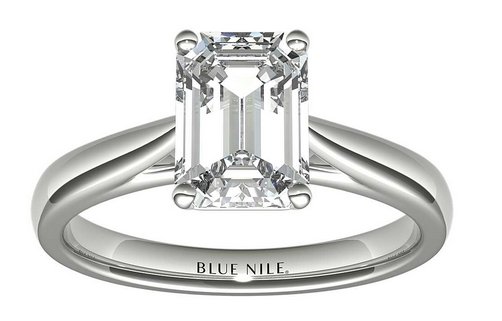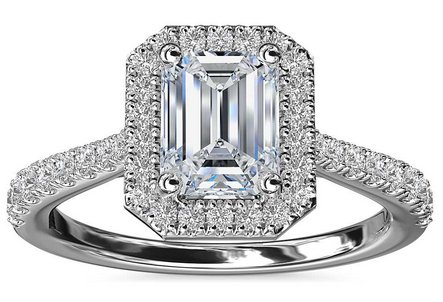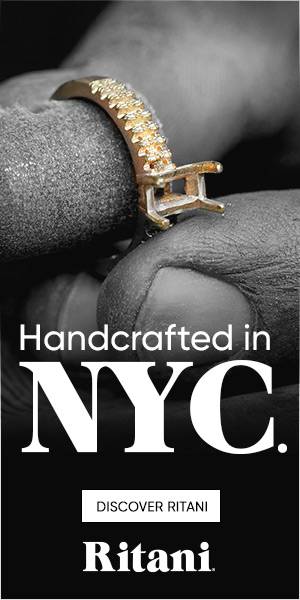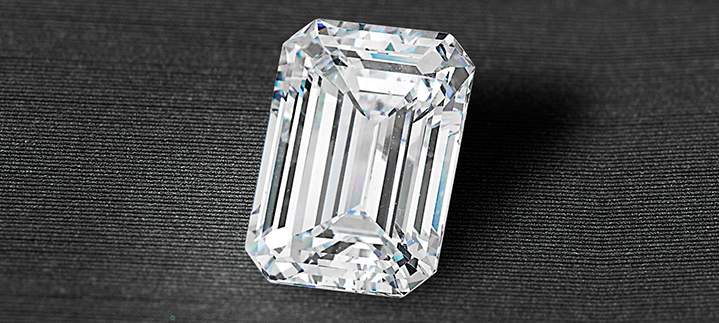
Do you love emerald cut diamonds?
I do!
It's one of my favorite diamond shapes. Elegant, suave, sophisticated, with understated beauty.
Emerald cut diamonds are for those people who have an inner confidence, a depth and clarity of soul that can only be matched by the smooth, refined honesty represented by the emerald cut.
And yet the emerald cut does not outshine its wearer. It complements their strength and confidence.
If selecting an emerald cut from Ritani what we want are the highest clarity diamonds.
Who This Article is For
In this article I will be going over how to use the advanced options when shopping for emerald cut diamonds online. Images are supplied by Ritani.com and BlueNile.com you can apply this advice to a broad selection of online diamond jewelers.
You don't need to be proficient in diamond knowledge in order to use this guide, but a knowledge of the 4C's is preferable. If you are completely new to diamonds I have a free ebook that I am giving away which contains all the basics. Get it here: The Complete Beginner's Guide to Diamond Engagement Rings.
So to begin with open up a tab with https://www.ritani.com/collections/emerald-cut-diamond in the address bar or navigate to it from their home page.
A few Asscher cut diamonds will be included in the search results. I'll explain more about them a little further down.
Getting To Know Emerald Cut Diamonds
The Emerald cut diamond shape has been around for a good 500 years. Gem cutters had already been cutting actual emeralds (you know, the green gemstones) into a rectangular shape. This is because of the difference in hardness between diamonds and emeralds makes it necessary to cut emeralds differently to how diamonds are cut. Emeralds themselves do not have the same hardness that diamonds have. This makes emeralds more prone to breaking. At some point gemstone cutters decided to cut emeralds with stepped facets. They had found that this shape made emeralds less prone to breakage. Stepped facets are arranged on all four sides of the diamond. Any gem with parallel, receding facets is called a step cut. The oblong shape which is cut in a way emeralds were originally all cut is an "emerald cut" even if it is a diamond or other gem.
The Difference Between Emerald, Radiant, and Asscher Diamonds
Radiant cut diamonds and Asscher cut diamonds both share some traits with emerald cuts. Yet they both have quite a different feel to emerald cut diamonds.
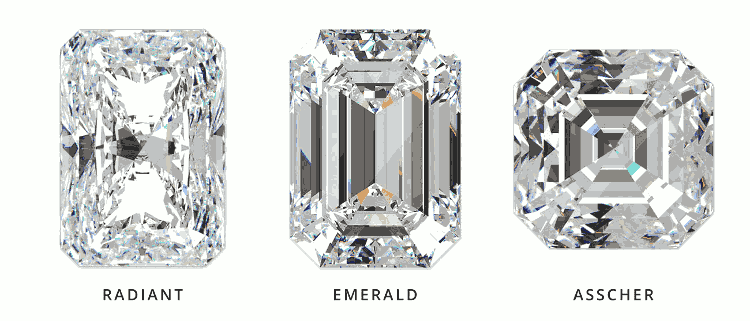
This photo shows a radiant, emerald, and an asscher cut diamond.
Radiant cut diamonds
Radiant cut diamonds might at first glance look quite similar in shape to emerald cut diamonds. They do have an outline that is pretty much the same as the outline we get from an emerald cut diamond. They both have a rectangular outline and their corners are cropped. But the way the different cuts sparkle is markedly dissimilar. This is caused by the facets of these two cuts being arranged in two entirely different manners. The facets on a radiant cut diamond are quite a bit smaller. Radiant cut diamond facets are aligned in such a way to produce excellent scintillation. The large facets of the emerald cut help emphasize the diamond's clarity. This makes the shape less of a dazzler and more of a quiet achiever. The arrangement of facets allows us to peer inside the diamond's depths. Both radiant cut diamonds and emerald cut diamonds have their own attractiveness, their own personality.
Asscher cut diamonds
Asscher cut diamonds share a similarity with Emerald cut diamonds in that they are both step cut diamonds. And yet they both present very differently. The Asscher cut diamond is close to a 1:1 ratio across the top. This gives it a square look, though it also has its corners cropped. The corner facets narrow into the pavilion's point which is the very center in Asscher cut diamonds. This is because they are square. This arrangement of facets gives them a distinctive pattern visible through the table facet which looks like an X. The alignment of an Asscher cut diamond's facets give it greater brilliance than we get from emerald cut diamonds. Asscher diamonds are sometimes included in the same category as emerald cut diamonds as they are both step cut diamonds. They may therefore also show up in searches for emerald cut diamonds at Ritani. Asscher's distinctive shape and patterning, though, is unmistakable.
The Appeal and Beauty Of Emerald Cut Diamonds
Every year there is a wave of popularity for different alternative diamond shapes. Round brilliants always keep top spot, but other shapes like emerald cut diamonds have gained popularity in recent years. It's usually buyers looking to go beyond the classic round diamond shape that choose fancy cuts like emerald cut diamonds. Emerald cut diamonds are still a rare and distinctive choice: Ritani reports that it's around 5% of their customers that choose an emerald cut. Emerald cut diamonds are often chosen by people who want something elegant, not too dazzling, but which still makes a bold statement of individuality. Grace Kelly, Amal Clooney, Jennifer Lopez, Angelina Jolie, Elizabeth Taylor, and Beyonce are some of the better known examples of women wearing emerald cut diamonds according to Town And Country Magazine. Emerald cut diamonds are for a woman who wants something that stands out from the crowd yet is still a classic. They appeal to the self-assured woman who celebrates understated elegance. The emerald cut is loved by many connoisseurs of jewelry. Many people love emerald cuts as they consider them to have a certain purity and find that they suit their individuality more than the more frequently seen round brilliant cut diamonds
Emerald Cut Diamonds Look Bigger
Emerald cut diamonds, along with any other elongated shapes do look larger for their weight when compared to most other shapes. The top table area of an emerald cut diamond is bigger than a round cut diamond of equal weight. If you put two diamonds side by side, one being a 1 carat round cut diamond and the other being a 1 carat emerald cut diamond, you will think that the emerald cut is a bigger stone. Many people like the effect emerald cut diamonds have when worn in engagement rings. It is said that emerald cut diamonds make your fingers look long and slender.
An Expression Of Individuality
The cut has enough variation so the person's individuality can be expressed by choosing an emerald cut that suits them just right. Emerald cut diamonds come in a wonderful array of shapes and ratios to suit different styles, preferences and tastes. Are you thinking more 'swimming pool' or 'tennis court'? Do you want something more rectangular or would a squarish emerald cut be more your thing? This kind of choice isn't something you get when looking at round brilliant cuts. Round brilliant cuts all strive for the ultimate brilliance and the hunt for the perfect round brilliant is entirely different to the hunt for the perfect emerald cut.
Buying An Emerald Cut Diamond: What To Look For
There is a wonderful amount of diversity among emerald cut diamonds. The proportions considered to be ideal for an emerald cut diamond are much more varied and allow for a great deal more possibility. Your personal taste will be the deciding factor. Having said that, here are a few tips and pointers for choosing an emerald cut diamond you will love.
Dimensions
Ideal Proportions
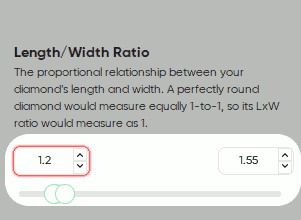
Since the initial listing of all Ritani's emerald cut diamonds includes Asscher cuts as well we can easily exclude those by changing the length to width ratio.
Asscher cut diamonds have a 1:1 ratio so changing the length to width ratio in the Advanced Options to anything above that will make the Asscher cut diamonds disappear from the search results.
The number on the left is the minimum for the range to be displayed, and the number on the right is the maximum.
So for 1:1.2 - 1:1.55 ratios type in "1.2" and "1.55" respectively.
What Is The Ideal Length to Width Ratio?
There is a lot of room for personal preference here, but there seem to be certain length to width ratios that are considered the nicest. Once you have eliminated the Asscher cut diamonds, begin looking through the diamonds that have an image. (There are some diamonds that have a stock image, so ignore those.)

This is a popular choice: 1:45

My recommendation is a 1:1.45 to 1:1.55 ratio for emerald cut diamonds. 
It's also not unheard of for some people to prefer more elongated look.
The 1:1.6 ratio is known as the golden ratio and might be just the thing for you.
If you don't know which ratio you like, start with a search that displays all the emerald cut diamonds within your budget. Then you can start to drill down eliminate ones that don't suit you.
Begin to narrow down the search results by entering the range of length to width ratio in the advanced settings. Type in 1.45 and 1.55 respectively in the Length/Width ratio boxes. Check the search results and see if they appeal to you.
Depth
The diamond’s depth (measured in percentage of width) is one of the factors that determine how much light a diamond returns. This is a percentage calculated based on the diamond's width. For example if an emerald cut diamond has the following measurements:
- Size (mm): 6.23 x 4.24 x 2.8
We can easily calculate the diamond's depth percentage by dividing the smallest number by the next smallest number.
The smallest number will almost invariably be the depth measurement.
In this case it is 2.8 mm.
So we calculate it like this: 2.8 ÷ 4.24 = 0.6603...
This means it has a depth percentage of 66.03%
If your calculation of a diamond's depth percentage is marginally different to the one shown on a diamond grading report don't be alarmed. The lab will have measured the diamond precisely and used those measurements in calculating the diamond's depth percentage. Those same numbers are then rounded up or down to the nearest two decimal places and entered into the report. The depth percentage on the grading report is therefore calculated before rounding so it will be more accurate than the one we calculate ourselves. Luckily Ritani displays the diamond's depth percentage and allows us to search for specific depth percentages in the Advanced Options.
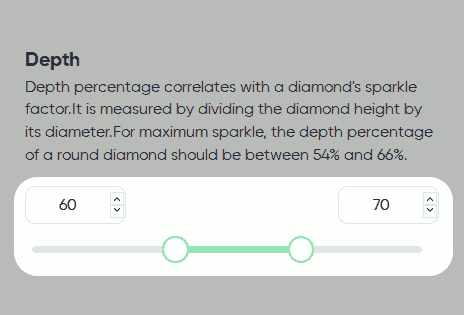
I recommend a depth percentage of 60% to 70% for all emerald cut diamonds regardless of length to width ratios. This generally produces the highest level of brilliance.talk to
Ideal Clarity
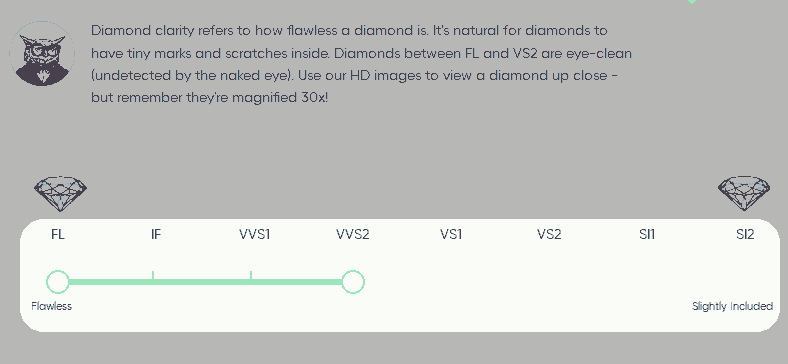
Emerald cut diamonds allow you to look deep inside them. They don’t hide their inclusions hardly at all. Their long, open facets encourage us to peer inside them. A high clarity grade is paramount. I recommend looking for emerald cut diamonds with the following clarity grades: IF, FL, VVS1, VVS2
Ideal Cut Grade
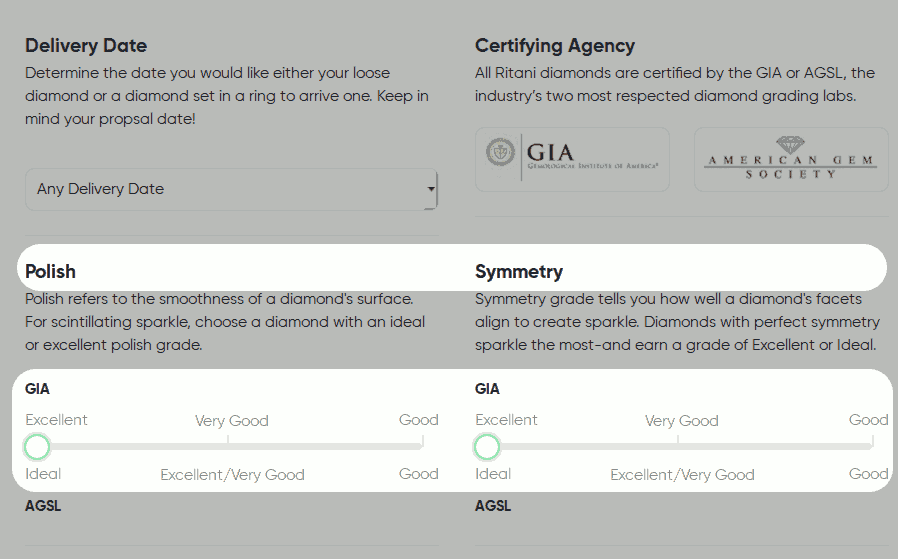
Neither GIA nor AGS assign cut grades to emerald shaped diamonds. What we have to look at therefore are emerald cut diamonds' polish and symmetry grades. Diamond retailers often look at the quality of polish, symmetry and proportions to get an idea of an emerald diamond’s cut grade. These factors are important indicators of sparkle and are all we have to work with in th case of emerald cut diamonds. Select an emerald cut diamond that has received an Excellent polish and Excellent symmetry grade. This ensures you will get a diamond with the most sparkle.
Color Grade
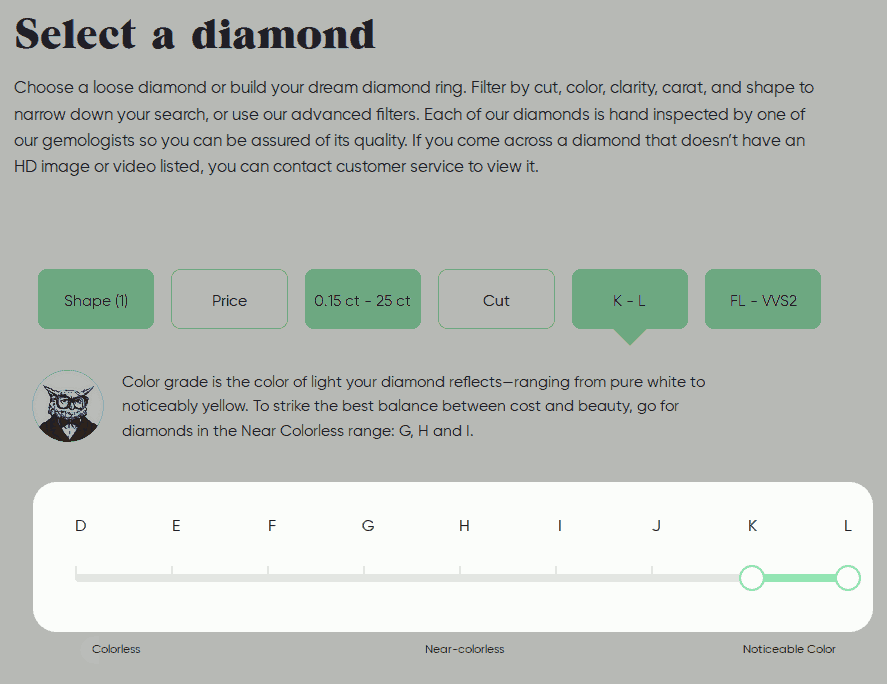
This one is entirely a personal choice. If anyone tells you there is a “best” color grade for emerald cut diamonds ask them what they mean by "best". It's no secret that a lighter color diamond costs more due to its rarity. The color grade you choose should only be based on what you find appeals to you the most. Ritani reports that since they began selling diamonds (way back in '99), many customers have shown to prefer the warmer color emerald cuts. This can be anything from G, H, I, J or even a K color. If you do go for a diamond that has a lot of color I recommend checking to make sure the color is yellowish rather than brownish. Brownishness indicates a defect in the structure of the diamond while yellowishness is merely the presence of trace nitrogen. A gold setting can enhance the yellow of the diamond, while a white metal setting makes the color less noticeable.
I would therefore suggest first looking at the K-L diamonds and then working your way up from there until it meets your budget.
Near Colorless Grades
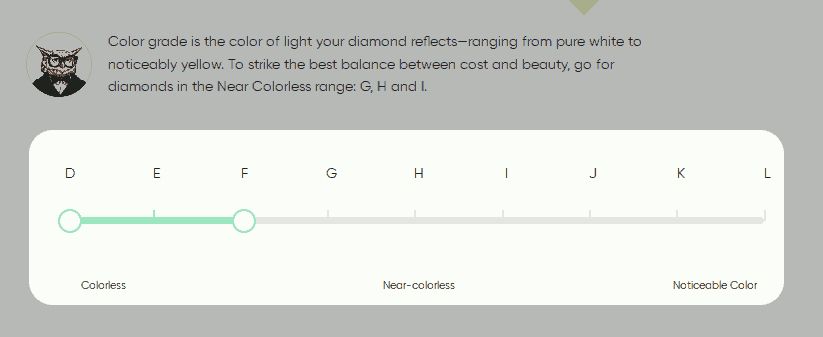
I suspect however that the more appealing color grades are going to be the near colorless grades of D-E-F. It's really not a bad idea to talk to Ritani's trained gemologists about this as they will be able to give you some indication about the relative warmth that the K-L diamonds have. I tend to prefer my emerald diamonds to be either totally clear or to have discernible color. The in between colors, particularly if they look gray at all really don't appeal. For that reason I like looking at the two extremes of the color grade range. I know, I know, budget often determines which end of the color grade ends up looking good, but I am merely sharing my honest opinion.
Carat Weight
The carat weight you choose will be determined by your budget. While there's been a great deal of appreciation for 1 - 1.5 carat diamonds in recent years this has not always been the average size of an engagement ring diamond. Just half a century ago the average size for engagement rings was 0.38 carats. In the end your wallet will determine how many carats your diamond will be. Remember that the warmer colors are more affordable thereby allowing you to buy a larger diamond.
Choosing A Setting For Emerald Cut Diamonds
Solitaire settings like this tapered cathedral ring and halo settings are very nice choices that go well with emerald cut diamonds. Solitaire settings are great if you like the understated beauty of an emerald to stand on its own. A halo setting is great if you want to add some sparkle to your ring. It also adds to the overall appearance of its size.
The Price Of Emerald Cut Diamonds
Emerald cut diamonds only make up about 3% of the global supply of cut diamonds. And as you know the law of supply and demand places emerald cut diamonds in the higher cost per carat category. However since they tend to look big for their size many people don't find this a deterrent. The fact that they are rare and highly valued no doubt makes up a part of their appeal.
The Price Of An Emerald Cut Engagement Ring
The cost of an emerald cut engagement ring will depend not only on the price of the diamond you choose but also on the type of ring setting you choose. Ritani's gemologists are a great resource to help you to choose a beautiful diamond you will love and cherish.
How Much Should I Expect To Pay For An Emerald Cut Diamond?
The cost of a 1 carat emerald cut diamond at Ritani starts around $1,700 and goes up from there to about $7,200 depending on what color and clarity is chosen. Ritani is the only online retailer that has total transparency in regards to their pricing. Each diamond listed includes how much their costs are and what their markup is.
The bottom line is that an emerald cut is an elegant, sophisticated diamond. The uniqueness of each emerald cut diamond means that it is an expression of one's individuality. If you’re interested in an emerald cut diamond engagement ring and would like to speak to a consultant I recommend getting in touch with Ritani's non-commissioned gemologists. They know what they are talking about and will help you find the perfect diamond that will make your heart sing.
